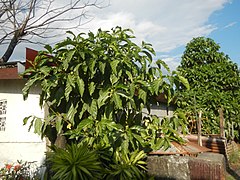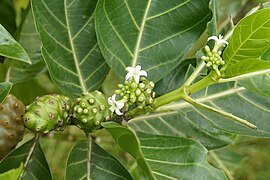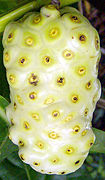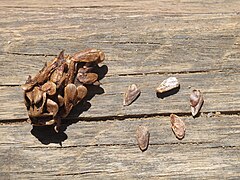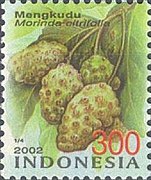Morinda citrifolia
| Morinda citrifolia | |
|---|---|

| |
| Leaves and fruit | |
| Scientific classification | |
| Kingdom: | Plantae |
| Clade: | Tracheophytes |
| Clade: | Angiosperms |
| Clade: | Eudicots |
| Clade: | Asterids |
| Order: | Gentianales |
| Family: | Rubiaceae |
| Genus: | Morinda |
| Species: | M. citrifolia
|
| Binomial name | |
| Morinda citrifolia | |
| Synonyms[1] | |
|
16 synonyms
| |
Morinda citrifolia is a fruit-bearing tree in the coffee family, Rubiaceae, native to Southeast Asia and Australasia, which was spread across the Pacific by Polynesian sailors.[2] The species is now cultivated throughout the tropics and widely naturalised.[3] There are over 100 names for this fruit across different regions, including great morinda, Indian mulberry, noni, beach mulberry, vomit fruit, awl tree, and rotten cheese fruit.[4]
The pungent odour of the fresh fruit has made it a famine food in most regions, but it remains a staple food among some cultures and is used in traditional medicine. In the consumer market, dietary supplements are sold in various formats, such as capsules and juices.

Common names
Mengkudu besar, inda, menkudu, Indian mulberry, awl tree, brimstone tree, great morinda, cheese fruit, noni, mengkudu,[5] keloré (in Lamalera, Flores island).[6]
Description
Morinda citrifolia is a shrub or small tree up to 6 m tall, with grey-brown bark. The twigs are more or less square in cross-section and often fleshy. Stipules are present, very broad and obtuse at the apex, measuring up to 2 cm wide and long. The large glabrous leaves are arranged in opposite pairs on the twigs, reaching up to 25 cm long by 13 cm wide. They are elliptic to ovate in shape and have 6–9 pairs of lateral veins. Domatia are usually present as dense tufts of hairs in the junctions of the lateral veins with the midrib.[7][8][9][10]: 182
The inflorescences are dense heads of flowers produced at the apex of the branch. They are leaf-opposed, replacing one leaf in the pair. There may be up to 90–100 flowers in the head, but only a few open at a time. The flowers are white and tubular with five lobes, measuring about 15 cm long and across.[7][8][9][10]: 182
The fruit is a multiple fruit consisting of fused drupes, each containing four seeds. They are initially green, transitioning through pale yellow to white or grey, and when ripe they emit a pungent odour similar to blue cheese. They are irregularly ellipsoid or ovoid, and may reach up to 9x6 cm.[7][8][9][10]: 182
Phenology
The plants flower and fruit throughout the year. It is common to see flowers and fruit in varying stages of development on a plant at any given time.[8][10]: 182 [11]
Growing habitats
Morinda citrifolia grows in shady forests and on open rocky or sandy shores.[12] It takes 18 months for the plant to mature, and yields 4 and 8 kg (8.8 and 17.6 lb) of fruit per month throughout the year. It is tolerant of saline soils, drought conditions, and secondary soils. It can be found in various environments including volcanic terrains and clearings or limestone outcrops, as well as in coral atolls.[12] It can grow up to 9 m (30 ft) tall and has large, simple, dark green, shiny, and deeply veined leaves.
Ecology
Morinda citrifolia is attractive to weaver ants, which make their nests by using the leaves of this tree.[12] These ants protect the plant from some plant-parasitic insects. The smell of the fruit also attracts fruit bats, which aid in dispersing the seeds. Drosophila sechellia, a type of fruit fly endemic to the Seychelles, feeds exclusively on these fruits.[13]
Uses
A variety of beverages (juice drinks), powders (from dried ripe or unripe fruits), cosmetic products (lotions, soaps), oil (from seeds), and leaf powders (for encapsulation or pills) have been introduced into the consumer market.[11]
Culinary
Indigenous peoples used the fruit as emergency food during famines.
In Cambodia, the leaves are an essential part of the national dish fish amok.[17]
Traditional medicine
Green fruit, leaves, and root or
Dyes
The fruit has traditionally been used by
Applying a mordant to the fabric before dyeing is necessary when using extracts of this plant as a dye. This process can be labor-intensive if the goal is to achieve shades and hues with the morinda dye.[21]
Popular culture
The fruit is widely used in eating challenges in the British reality television program I'm a Celebrity...Get Me Out of Here! where it is referred to as "vomit fruit."[22]
Nutrients and phytochemicals
Morinda citrifolia fruit powder contains carbohydrates and dietary fibre in moderate amounts.
Morinda citrifolia fruit contains several
Gallery
-
Residential habit
-
Sapling
-
Budding inflorescence
-
Flower with ants
-
Fruit in varying stages of development
-
Ripe fruit
-
Close-up of the large stipules
-
Seeds
-
Trunk
-
Postage stamp from Indonesia
See also
References
- ^ a b "Morinda citrifolia L." Plants of the World Online. Royal Botanic Gardens, Kew. 2024. Retrieved 12 May 2024.
- ISBN 0415927463.
- ^ Nelson, SC (2006-04-01). "Species Profiles for Pacific Island Agroforestry: Morinda citrifolia (noni)". Traditional Tree Initiative.
- ^ "Some worldwide names for Morinda citrifolia L." The Noni Website. University of Hawai‘i at Manoa, College of Tropical Agriculture and Human Resources. 2006. Retrieved 11 June 2023.
- ^ "Morinda citrifolia L." nparks.gov.sg. National Parks, Singapore government agency. Retrieved 2024-06-09.
- ISSN 0169-9865.
- ^ a b c F.A.Zich; B.P.M.Hyland; T.Whiffen; R.A.Kerrigan (2020). "Morinda citrifolia". Australian Tropical Rainforest Plants Edition 8 (RFK8). Centre for Australian National Biodiversity Research (CANBR), Australian Government. Retrieved 12 May 2024.
- ^ a b c d "Morinda citrifolia L." Flora of China (eFloras). Missouri Botanical Garden, St. Louis, MO & Harvard University Herbaria, Cambridge, MA. Retrieved 12 May 2024.
- ^ a b c d "Morinda citrifolia - Indian Mulberry". Cook Islands Biodiversity. The Cook Islands Natural Heritage Trust. Retrieved 12 May 2024.
- ^ a b c d "RUBIACEAE (Wong et al.)". Flora of Singapore. Singapore Botanic Gardens. Retrieved 12 May 2024.
- ^ a b c d e Scot C. Nelson. "Morinda citrifolia L." (PDF). Agroforestry. Permanent Agriculture Resources. Archived from the original (PDF) on 13 November 2016. Retrieved 12 May 2024.
- ^ a b c Nelson, Scot C (March 2001). "Noni cultivation in Hawaii" (PDF). The noni website, University of Hawai‘i at Manoa, College of Tropical Agriculture and Human Resources. Retrieved 12 November 2016.
- PMID 9691045.
- ISBN 978-0-8248-1225-6.
- S2CID 41054660.
- ^ Cribb, A.B. & Cribb, J.W. (1975) Wild Food in Australia. Sydney: Collins.[page needed]
- ^ Veasna. "Cambodian Fish Amok". Food.com. Warner Bros. Discovery, Inc.
- PMID 17286240.
- ^ Darla Bracy, Division Director (18 July 2018). "Warning letter: Hawaiian Organic Noni, LLC". Inspections, Compliance, Enforcement, and Criminal Investigations, US Food and Drug Administration. Retrieved 15 August 2018.
- ^ Allam, Lorena; Moore, Isabella. "'Bringing the sun in': the hardworking weavers of Bula'Bula dig colour from the red earth". The Guardian. Retrieved 26 August 2023.
- JSTOR 20205554.
- ^ "What is vomit fruit, as seen on I'm A Celebrity?". Metro. 23 November 2019. Retrieved 11 November 2022.
- ^ a b c Nelson, Scot C. (2006) "Nutritional Analysis of Hawaiian Noni (Noni Fruit Powder)" The Noni Website. Retrieved 15-06-2009.
- ^ a b Nelson, Scot C. (2006) "Nutritional Analysis of Hawaiian Noni (Pure Noni Fruit Juice)" The Noni Website. Retrieved 15-06-2009.
- ^ a b "Nutrition data for raw oranges, all commercial varieties, per 100 gram amount". Nutritiondata.com. Conde Nast for the USDA National Nutrient Database, Release SR-21. 2014. Retrieved 12 November 2016.
- ISSN 0021-8561.
- PMID 461575.
External links
- View a map of herbarium collections of this species at the Global Biodiversity Information Facility
- View observations of this species on iNaturalist
- See images of this species on Flickriver.com

